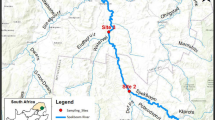Abstract
Gomti river receives industrial as well as domestic wastes from various drains of Lucknow city. In the process the water and sediment of the river Gomti get contaminated with heavy metals and other pollutants. In the present study, impacts of domestic/industrial wastes on the water and sediment chemistry of river Gomti with special reference to heavy metals have been investigated in different seasons (summer, winter and rainy). For this, seven sampling sites: Gaughat, Mohan Meakin, Martyr’s Memorial, Hanuman Setu, Nishatganj bridge, Pipraghat and Malhaur, in the river Gomti in Lucknow region were identified and samples of water and sediments were collected in all the three seasons. In the collected water and sediment samples, six metals (Cd, Cr, Cu, Ni, Pb, and Zn) were analyzed on ICP-AES (Inductively coupled plasma emission spectroscopy) Labtam Plasmalab 8440. High concentrations of all the metals were noticed in water and sediment in rainy season compared to summer and winter. Because in rainy season runoff from open contaminated sites, agricultural field and industries, directly comes into the river without any treatment. In both the cases, the concentration of zinc was maximum (0.091 μg/ml in water and 182.13 μg/g in sediment) and the concentration of cadmium (0.001 μg/ml in water and 17.26 μg/g in sediment) was minimum. Higher concentration of metal in water and sediment during rainy season could be due to the industrial/agricultural/domestic runoff coming into the river.
Similar content being viewed by others
References
Ajmal, M., Khan, M.A. and Nomani, A.A.: 1983, ‘Pollution in the river Ganges (India)’, Water Sci. Technol. 16, 347–358.
Ansari, A.A., Singh, I.B. and Tobschall, H.J.: 2000, ‘Importance of geomorphology and sedimentation process for metal dispersion in sediments and soils of the Ganga plain: Identification of geochemical domains’, Chem. Geol. 162, 245–266.
APHA, AWWA and WEF: 1998, Standard Methods for the Examination of Water and Waste Water, 20th edition.
Chekushin, V.A., Bogatyrev, I.V., Finne, T.E., Misund, A., Niskavaara, M., Pavlov, V.A., Volden, T. and Ayras, M.: 1993, Report on Joint Ecogeochemical Mapping and Monitoring in the Scale of 1:1 Million in the West Murmansk Region and the Contiguous Areas of Finland and Norway, Norgis Geologiske Undersokelse, Report 93, 152–132.
Datta, D.K. and Subramanian, V.: 1998, ‘Distribution and fraction of heavy metals in the surface sediments if the Ganges-Brahmaputra-Meghana river system in the Bengal besin’, Environ. Geol. 36, 93–101.
Dean, J.G., Bosqui, F.L. and Lanouetle, K.H.: 1972, ‘Removing heavy metal from waste waters’, Environ. Sci. Technol. 6, 518–522.
Duncan, P.H.L. and Harrison, R.M.: 1981, ‘Cleaning methods for polythene container prior to determination of trace metals in freshwater samples’, Anal. Chem. 53, 345.
Forstner, U. and Wittman, G.T.W.: 1983, ‘Metal Pollution in Aquatic Environment, Springer-Verlag Berlin, Heidelberg, New York, 484 pp.
Gibbs, R.J.: 1977, ‘Transport phases of transition metals in the Amazon and Yukon Rivers’, Geol. Soc. Am. Bull. 88, 829–843.
Golterman, M.I.: 1967, ‘Influence of soil on the chemistry of water in relation to productivity’, FAO Fish Rep. 44, 27–42.
Jenne, E.A.: 1968, ‘Control of Mn, Fe, Co, Ni, Cu and Zn concentrations in soils and water: The significant role of hydrous Mn and Fe oxides’, Adv. Chem. Ser. 73, 337–387.
Jha, P.K., Subramanian, V., Sitasawad, R. and Van Grieken, R.: 1990, ‘Heavy metals in water and sediments of the Yamuna river (a tributary of the Ganga)’, Sci. Total Environ. 95, 7–27.
Johnson, C.A. and Thornton, I.: 1987, ‘Hydrological and chemical factors controlling the concentrations of Fe, Cu, Zn and As in a river system contaminated by acid mine drainage’, Water Res. 21, 359–365.
Konhauser, K.O., Powell, M.A., Fyfe, W.S., Longstaffe, F.J. and Tripathy, S.: 1997, ‘Trace element geochemistry of river sediment, Orissa State, India’, J. Hydrol. 193, 258–269.
Kumar, S.: 1989, ‘Heavy metal pollution in Gomti River sediment around Lucknow, Uttar Pradesh’, Curr. Sci. 58(10), 557–559.
Mathew, K. and Vasudevan, N.T.: 2002, ‘Trace metals in the sediments of river Pamba’, Pollut. Res. 21(3), 235–242.
Moon, C.H., Lee, Y.S. and Yoon, T.H.: 1994, ‘Variation of trace Cu, Pb and Zn in sediment and water of an urban stream resulting from domestic effluents’, Water Res. 28(4), 985–991.
Muller, G.: 1979, ‘Schwermetalle in den Sedimenten des Rheins-Veranderungen Seit 1971’, Umschau 79(24), 778–783.
Ramchandran, R.: 1989, Urbanisation and Urban System in India, Oxford University Press, Delhi, 364 pp.
Ramesh, R., Ramanathan, A.L., Ramesh, S., Purvaja, R. and Subramanian, V.: 2000, ‘Distribution of rare earth elements in the surficial sediments of the Himalaya river system’, Geochem. J. 34, 295–319.
Saikia, D.K., Mathur, R.P. and Srivastava, S.K.: 1988, ‘Heavy metals in water and sediments of upper Ganga’, Indian J. Environ. Health 31(1), 11–17.
Singh, M., Ansari, A.A., Muller, G. and Singh, I.B.: 1997, ‘Heavy metals in freshly deposited sediments of Gomti river (a tributary of the Ganga river): Effects of human activities’, Environ. Geol. 29(3/4), 246–252.
Singh, M., Muller, G. and Singh, I.B.: 2002, ‘Heavy metals in freshly deposited stream sediments of rivers associated with urbanization of the Ganga plain, India’, Water Air Soil Pollut. 141, 35–54.
Singh, M.: 2001, ‘Heavy metal pollution in freshly deposited sediments of the Yamuna river (the Ganga river tributary): A case study from Delhi and Agra urban centres, India’, Environ. Geol. 40, 664–671.
Singh, M., Muller, G., and Singh, I.B.: 2003, ‘Geogenic distribution and baseline concentration of heavy metals in sediments of the Ganges river, India’, J. Geochem. Explor. 80, 1–17.
Solomons, W. and Forstner, U.: 1984, Metals in Hydrocycle, Springer-Verlag Berlin Heidelberg, New York.
Subramanian, V., Van Grieken, R. and Vant Dack, L.: 1987b, ‘Heavy metal distribution in the sediments of Ganga and Brahmaputra Rivers’, Environ. Geol. Water Sci. 9, 93–103.
Thornton, J.A., McComb, A.J. and Ryding. S.O.: 1975, ‘The Role of Sediments., in: A.J. McComb (ed), Eutrophic Shallow Estuaries and Lagoons’, CRC Press, Boca Raton Florida, USA, 205–223 pp.
Author information
Authors and Affiliations
Corresponding author
Rights and permissions
About this article
Cite this article
Gaur, V.K., Gupta, S.K., Pandey, S.D. et al. Distribution of heavy metals in sediment and water of river Gomti. Environ Monit Assess 102, 419–433 (2005). https://doi.org/10.1007/s10661-005-6395-6
Received:
Accepted:
Issue Date:
DOI: https://doi.org/10.1007/s10661-005-6395-6




